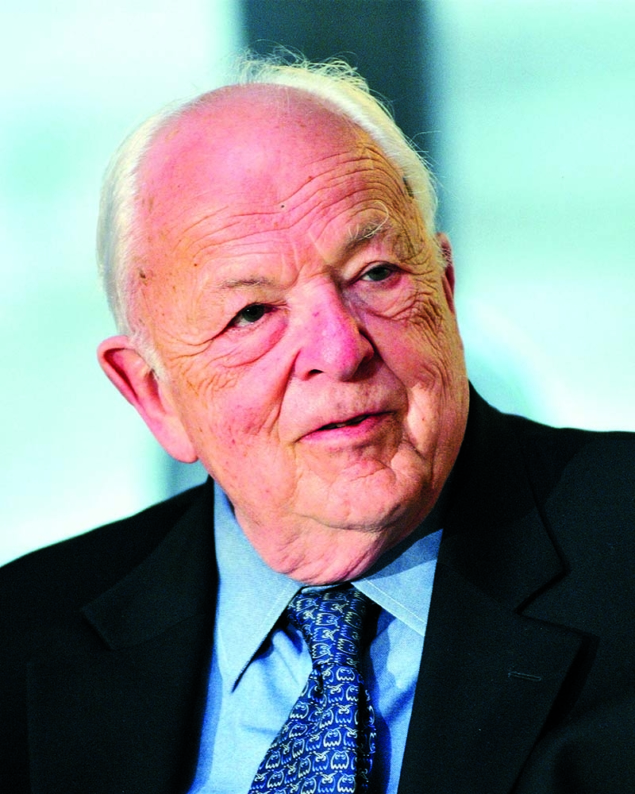
Burton Richter, a major figure in particle physics who shared the Nobel Prize for the co-discovery of the J/ψ meson, passed away on 18 July in Palo Alto, California, at the age of 87.
Born in Brooklyn, New York, in 1931, Richter’s love of science began with the nightly blackouts during World War II, which revealed an unparalleled view of the night sky.
He studied physics at the Massachusetts Institute of Technology (MIT), where he was introduced to the electron–positron system by Martin Deutsch, who was conducting classical positronium experiments. He wrote his thesis on the quadratic Zeeman effect in hydrogen and completed his PhD in 1956 on the photoproduction of pi-mesons from hydrogen.
That year, Richter moved to Stanford University’s high-energy physics laboratory as a research associate. In 1960, he became an assistant professor of physics, then associate professor in 1963 and professor in 1967. During this time, Richter married his wife, Laurose, and had two children, Elizabeth and Matthew. By 1970, Richter’s talents in experimental particle physics and accelerator physics led to the Stanford Positron-Electron Asymmetric Ring (SPEAR) at the Stanford Linear Accelerator Center (SLAC). It included a groundbreaking type of general-purpose detector that has been used in particle colliders ever since, and it would eventually produce his biggest discovery.
After Richter secured funding for SPEAR in 1970, it took him just 27 months to build the accelerator, at a cost of $6 million. Experiments commenced in 1973 and, famously, in November 1974, SPEAR flushed out what the SLAC team dubbed the “psi” meson – a bound state of two charm quarks. Simultaneously, at Brookhaven National Laboratory on the other side of the continent, Sam Ting and his group had spotted the same resonance, which they christened the “J”. Just two years later, Richter and Ting shared the 1976 Nobel Prize in Physics for their pioneering discovery of the J/ψ, which proved the existence of a fourth type of quark (charm). It was a major step towards the establishment of the Standard Model of particle physics.
Before he received the Nobel Prize, in 1975 Richter began a sabbatical year at CERN, during which he pursued an experiment at CERN’s Intersecting Storage Rings (ISR) – the world’s first hadron collider. He was hosted by Pierre Darriulat and worked on adding a muon spectrometer arm to the R702 experiment. Richter also worked out the general energy-scaling laws for high-energy electron–positron colliding-beam storage rings, looking specifically at the parameters of a collider with a centre-of-mass energy in the range 100–200 GeV, arguing that such a machine would be required to better understand the relationship between the weak and electromagnetic interactions: “That study turned into the first-order design of the 27 km-circumference LEP project at CERN that was so brilliantly brought into being by the CERN staff in the 1980s,” he wrote in his Nobel biography.
His influential paper “Very High Energy Electron–Positron Colliding Beams for the Study of the Weak Interactions” (Nucl. Instrum. Methods 136 47) was followed by two detailed studies: one concerning the physics, published in November 1976 as CERN Yellow Report 76-18, of which Burt was a co-author, and an accelerator study headed by Kjell Johnsen. “Burt’s paper and his personal advocacy of high-energy electron–positron collision triggered interest at CERN, and had a powerful impact on the development of the Laboratory, also paving the way for the LHC and the discovery of the Higgs boson,” says CERN’s John Ellis.
In 1978, along with others at SLAC, Richter began to investigate the possibility of turning the 3.2 km linear accelerator at SLAC into a linear electron–positron collider. Construction of the SLAC Linear Collider (SLC) began in 1983, and Richter became director of SLAC the following year, until stepping down in 1999. During that time, he oversaw the construction of the SLC, the only linear electron–positron collider yet to be built, and led the way to other machines for photon science. While SLAC director, Richter also initiated interregional collaborations with DESY in Germany and KEK in Japan, and was a proponent of bringing into existence a high-energy linear collider as a global collaboration.
“Perhaps his greatest contribution as director was, in the 1990s, designing a future for SLAC that would look very different from the past,” said Stanford Provost Persis Drell, who served as SLAC director from 2007 to 2012. “He recognised that pursuing an X-ray free-electron laser at SLAC could be used to provide a revolutionary science opportunity to the photon science community, who use X-rays as their tool for discovery. This vision became the Linac Coherent Light Source. Burt recognised that outstanding science needed to drive the future of the institution, and he did not flinch from designing that future.”
When he stepped down as SLAC director, Richter focused on public policy issues in science and energy, for which he received the prestigious 2007 Philip Hauge Abelson Prize from the American Association for the Advancement of Science. In 2010, he published Beyond Smoke and Mirrors: Climate Change and Energy in the 21st Century, an apolitical layperson’s exploration of the facts of climate and energy. Among his many accolades, Richter received the US National Medal of Science, the nation’s highest scientific honour, in 2014; the Enrico Fermi Award in 2012; and the Ernest Orlando Lawrence Award in 1976.
“In my career I have met no one who has made more fundamental contributions in electron–positron and electron–electron colliders, in the precision instrumentation used in colliders and in experimental physics,” says Ting. “After we received the Nobel Prize together in 1976, I met him many times and we became good friends. My wife, Susan, and I are going to miss him deeply.”








